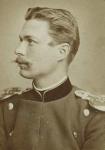-
Posts
2,234 -
Joined
-
Last visited
-
Days Won
55
Content Type
Profiles
Forums
Blogs
Gallery
Events
Store
Everything posted by Glenn J
-
Vince, he is shown as Karl Wilhelm Theodor in the 1873 Württemberg Rang- und Quartier-Liste. He entered the Württemberg army as a volunteer on 29 June 1866 and was commissioned on 13 April 1868 with a Patent of 2.5.68. Promoted to Premier-Lieutenant with a Patent of 18.7.70 H and to Hauptmann on 16.4.77. He was the holder of a Friedrichs Order Knight's Cross 1st Class with Swords and retired on 2 March 1888. Regards Glenn
-
That certainly corresponds with the situation given for October 1918 in a manuscript by Major a.D. Hans-Rudolf v. Stein. The battle credits for 49. Reserve-Division in this period were as follows: 14 Dec 1917 - 3 Apr 1918: Positional battles in Flanders and Artois 3 to 9 Apr 1918: Positional battles in Flanders 10 to 29 Apr 1918: Battle of Kemmel 30 Apr to 28 August 1918: Positional Warfare in Flanders Regards Glenn
-

16 Inf Regt (3rd Westphalian) 27th Bde 14 Inf Div?
Glenn J replied to E Williams's topic in The Great War 1914 to 1918
Ed, the Spring 1915 reorganisations reduced the infantry establishment of the infantry division to a single brigade of three regiments. The result was that the 14. Division was left with just the 79. Infanterie-Brigade with Infanterie-Regimenter 16, 56 & 57. The former 27. Brigade was renumbered as the 100. Infanterie-Brigade (50. Infanterie-Division) keeping its original IR 53 and receiving Füsilier-Regiment Nr. 39 from 28. Brigade which was disbanded and IR 158 from the 25. Infanterie-Brigade (13. Division). Regards Glenn -
The book is titled "Der oberste Kriegsherr und sein Stab. Die k. u. k. Wehrmacht in Wort und Bild". Wien 1908. It is huge!! Glenn
-
Bruce, Band Sergeant Major. The Bandmaster (WO1) wears a small Royal coat of Arms on the lower right arm as opposed to the large badge as worn by the Regimental Sergeant Major on the upper right arm. Note that Foot Guards RSMs assigned to positions outside their parent battalion (unless a former RSM of a Foot Guards battalion) also wear the small coat of arms on the lower arm. Regards Glenn
-

"FOR CAMPAIGN SERVICE"
Glenn J replied to Leuchtturm's topic in Great Britain: Orders, Gallantry, Campaign Medals
Simon, Chris, it appears to be mounted on a plain buckram board for service dress. I knew Paul years ago. That medal looks a bit battered though! Regards Glenn -
The peacetime establishment of a cavalry regiment was five squadrons consisting of four troops (Züge). On mobilisation one squadron remained behind as the Ersatz-Eskadron although not necessarily the 5. Eskadron. For example, the Ersatz-Eskadron of Husaren-Regiment Nr. 11 was the 2. Eskadron. There was no such thing as an HQ squadron. A Beritt has nothing to do with the training of horses; it is an in-barracks grouping equating to a Korporalschaft in the infantry. A Berittführer was the cavalry equivalent of a section commander/squad leader. Glenn
-
Claudio, A pre-war regular field artillery officer (although originally an infantry officer in IR 62 and IR 150). He was commanding 3./Mindensches Feldartillerie-Regiment Nr. 58 in 1914 having transferred to the field artillery (FAR 73) in 1906. Hauptmann: 1.10. 12 A Oberleutnant: 18.5.05 L1 (FAR 73) Sekonde-Lieutenant/Leutnant: 18.8.95 X4x He served with RFAR 14 during WW1. Glenn
-
Chip, presumably Leutnant Franz Graf Schaffgotsch. Commissioned into 1. Husaren-Regiment "König Albert" Nr. 18 with a Patent of 28.11.13. He appears in the 1914 Saxon army list as well as the Ehrenrangliste on page 919 which shows he died as a Leutnant a.D. on 29 September 1924. He was the holder of the Saxon Merit Order Knight's Cross 2nd Class with Swords and the Albrecht Order Knight's Cross 2nd Class with Swords. Regards Glenn




